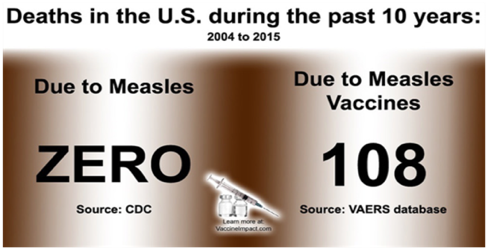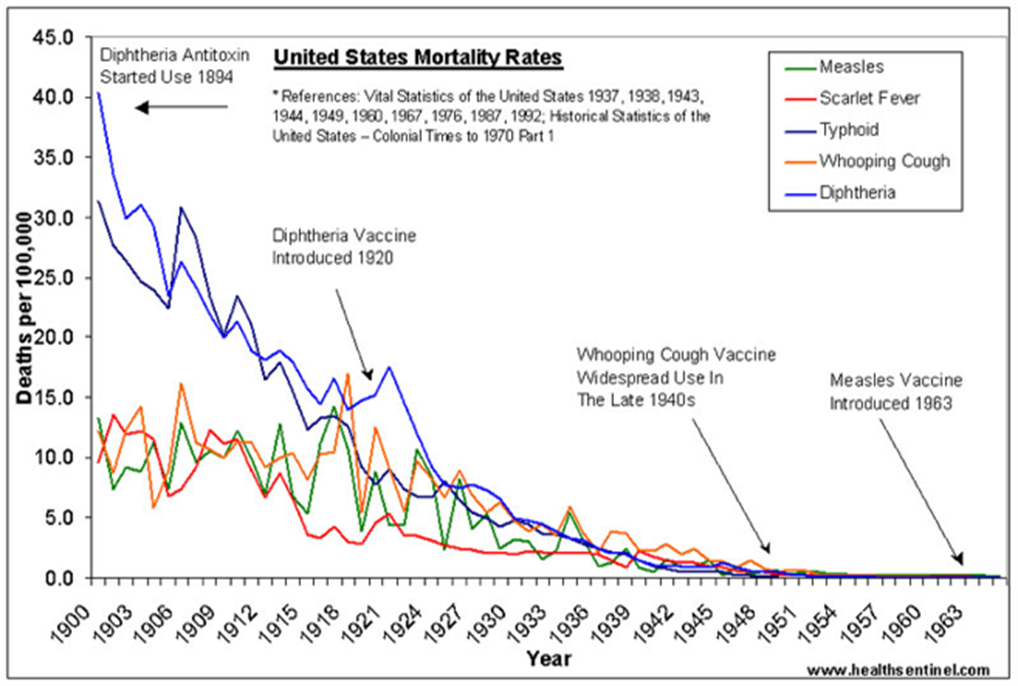






The current narrative is that all vaccines are safe, effective and necessary, the benefits outweigh the risks, we have a social responsibility to vaccinate, and without every available vaccine our children’s lives would be in danger.
Our desire to protect our children from harm makes it difficult to question ideas we’ve been told repeatedly will keep our children safe. We are inundated with vaccine marketing which states that the best way to have healthy children is to inject them with more than 90 vaccines by age 18. As a result, most parents accept, without question or investigation, the vaccine narrative.
As you read through this material I anticipate you will discover there is much about vaccines and the vaccine industry you didn’t know. This experience is not uncommon. Open and honest discussion about the effectiveness, safety and necessity of vaccination is actively censored by our governments and media. The decision of whether to vaccinate your children with any or all vaccines may be the most important decision you will make as a parent. The challenge of vaccination is that the consequences of these injections cannot be undone. Our children’s health depends on getting this decision right.
The messages that are routinely delivered by the pharmaceutical industry and mainstream media are that:
None of these statements, however, are scientific facts. Rather, these statements are opinions and assumptions masquerading as science. What follows are 20 reasons to question the vaccine narrative.

It’s important to understand that the practice of injecting viruses, bacteria and foreign substances into humans is unnatural. The human body is not designed to encounter pathogens and toxins via a needle. The usual method of contracting a transmittable disease is through swallowing (ingestion) or breathing (inhalation). When vaccine ingredients are injected into the body, they bypass the normal protective barriers that activate our immune system and help to keep us safe.
Injection permits the contents in vaccines, including mercury, aluminum, viruses, foreign DNA, and other toxic ingredients to enter the bloodstream, make their way into organs, bones and tissues, cross the blood-brain barrier and gain access to the brain. Dr Richard Moskowitz cautions: “Vaccination is designed to accomplish by deception precisely what the whole immune mechanism has seemingly evolved to prevent – granting bacteria, viruses, and foreign antigens free and immediate access to the major internal organs of the body with no reliable means of getting rid of them.”
Vaccines contain a number of ingredients that are toxic to humans, most notably mercury and aluminum.
Mercury: Vaccine manufacturers use mercury (Thimerosal) in the production of many vaccines and as a preservative in multi-dose vials of the influenza vaccine. Mercury is recognized as the most toxic substance that is not radioactive. It is scientific fact that neurons in the human brain permanently disintegrate in the presence of mercury. There is no evidence that injecting mercury is safe in any amount.
Aluminum: Aluminum is another neurotoxin routinely used in vaccines. Aluminum has never undergone biological testing to determine whether it is safe to be injected into humans. Aluminum, like mercury, was ‘grandfathered’ into our medical system without the benefit of safety testing.
Aluminum causes damage to the brain affecting memory, cognition and psychomotor control. Clinical evidence indicates aluminum is a primary causal factor in dementia and Alzheimer’s disease. Aluminum interferes with gene expression and depresses mitochondrial function.
The amount of aluminum in many vaccines exceeds the maximum amount permitted by the FDA. A 2017 aluminum toxicity study conducted by Christopher Exley Ph.D., a world-renowned aluminum expert, found some of the highest quantities of aluminum ever recorded in the brains of autistic boys. The Hep B vaccine which contains toxic doses of aluminum is given to infants on their first day of life.
Vaccines contain harmful ingredients including: neurotoxins, chemically altered viruses, antibiotics, preservatives, detergents, stabilizers, neutralizers, carrying agents, Polysorbate 80, MSG, formaldehyde, glyphosate, genetically modified viruses, and other ingredients which counteract and/or bond synergistically thereby increasing their potential harm. Mercury and other heavy metals adversely affect the gastrointestinal, immune, nervous and endocrine systems. Heavy metals alter cellular function and numerous metabolic processes in the body, including those related to the central and peripheral nervous systems.
Animals and insects are used in the manufacture of vaccines. Animals used include: monkey, cow, chicken, duck, pig, sheep, dog, horse, rabbit, guinea pig and mice. The medium in which vaccine bacteria and viruses are cultivated include: rabbit brain tissue, dog kidney tissue, monkey kidney tissue, chicken or duck egg protein, chick embryo, calf serum and pig and horse blood. Once animal DNA, viruses and retroviruses insert themselves into human cells, they cannot be removed. The injection of animal DNA/RNA compromises the biological integrity of the human race.
The brain is particularly vulnerable to toxic exposures during both pregnancy and an infant’s early years. We recognize this with the risk of drinking alcohol during pregnancy. Pregnant moms are also advised to limit their intake of tuna and other fish known to contain high levels of mercury. Children are more vulnerable to toxins than adults because their immunological and neurological systems are still developing. A toxic exposure at the wrong moment can permanently damage an infant’s brain.
It is not just toxic exposures from the external environment that threaten normal brain development. It’s imperative we also recognize the risks of injecting toxic substances like mercury and aluminum into infants during critical periods of brain growth. Researchers have confirmed that aluminum in vaccines can be transported into the brain, provoking chronic brain inflammation. With the current CDC vaccination schedule, high quantities of aluminum are injected into an infant during periods of brain formation. No clinical studies have been conducted to establish the safety of injecting aluminum into infants and children.
The promise of vaccine-induced ‘herd immunity’ that protects others is used to coerce legislators, doctors, public health officials, medical personnel and the public into accepting vaccinations. What is not commonly known is that herd immunity is a theory based on the body’s response to natural infection. Natural infection provides life-long immunity in most cases. The immune response stimulated by vaccines is temporary, lasting a few years or even as short as a few months. The temporary effect of vaccines is self-evident given the ongoing need for boosters. There is no evidence to support the claim that the immunity stimulated artificially by vaccine injection creates long-term herd immunity.
Most parents assume that all vaccines prevent the contraction of disease. This is not true. Six childhood vaccines – polio, diphtheria, influenza, pertussis (whooping cough), tetanus and COVID-19 are not designed to prevent infection or transmission of disease. Their purported benefit is only to reduce the severity of symptoms should one become infected.
Four diseases targeted by vaccines – tetanus, Hepatitis B, HPV, and meningococcus are not transmitted through casual contact. Hep B, for example, is transmitted through sexual contact or IV drug use. In spite of this fact, Hep B is administered to infants on their first day of life.
Four of the diseases targeted by vaccines – Pneumococcus, Influenza, COVID, and HPV have so many strains, or mutate so rapidly, that vaccination does little to reduce the prevalence of the disease and actually causes an increase in the strains not covered by the vaccine.
Thus, an individual who has not been vaccinated for polio, diphtheria, tetanus, whooping cough, Hep B, Hib or COVID -19 poses no extra danger to the public than a person who is vaccinated. The government and media are dishonest when they claim that unvaccinated individuals are a threat to the community. This is marketing propaganda, not evidence-based medicine. It is fear mongering, not science.
Vaccine safety should lie at the heart of the vaccine decision. A vaccine with mild and transient adverse effects is unlikely to be of significant concern, even if the efficacy of the vaccine is less than promised. But a vaccine that can cause life-long disabilities and death is unacceptable, even if the vaccine is effective. The claim made by the vaccine industry is that all vaccines are rigorously tested in keeping with the highest possible safety standards. But is this true? The answer is no. The reasons vaccines cannot claim to be proven safe are the following:
a. Lack of a Neutral Placebo – The gold standard of safety research is to conduct a large clinical trial that compares a subject group with a control group. In the case of vaccine safety trials, the subject group would receive the vaccine. The control group would receive a placebo – a substance known to be harmless. Safety is determined by comparing the impact of the vaccine against the placebo. None of the vaccines on the childhood vaccine schedule, however, were tested for safety in this manner. No claims can be made about vaccine safety given that the safety trials for childhood vaccines are conducted without a neutral placebo.
b. Most Safety Trials Do Not Include Children – Many pre-licensure safety trials do not include patient populations most at risk of serious adverse events. The American Academy of Pediatrics published guidelines regulating the participation of children in clinical trials. The guideline said that drugs and vaccines should be tested on the population for which they are intended. This standard is not upheld in vaccine safety trials. Most vaccine safety trials utilize healthy adults and do not include infants and children and other vulnerable populations.
c. The Childhood Vaccination Schedule Has Never Been Studied for Safety – The current vaccine schedule recommends giving multiple vaccine injections at one time. There are no studies examining the effects of giving multiple injections at once. This makes the safety of the childhood vaccine schedule unproven.
d. Vaccine Injury Reporting is Inadequate – Vaccine adverse event monitoring is voluntary, superficial, and inadequate. Medical personnel are not trained to identify, diagnose and treat vaccine injury. And, there are no consequences for failing to report vaccine injury. A study conducted by Harvard Pilgrim Hospital concluded that less than 1% of vaccine injuries are reported.
e. The Vaccine Industry Routinely Dismisses Post-Vaccine Injuries and Deaths – Of the 2,605 infant deaths reported to the Vaccine Adverse Event Reporting System (VAERS) from 1990 through 2019, 58% clustered within three days post-vaccination, and 78% occurred within seven days. Rather than recognizing the risk of harm from vaccines, the vaccine industry states – “correlation is not causation”, meaning that just because an injury follows vaccination does not mean the vaccine caused the injury. The industry, however, makes no attempt to conduct studies to determine the cause of these deaths immediately following vaccination.
f. Medical Coding Disguises Death From Vaccines – There is no medical code to identify death due to vaccine injury. Vaccine related deaths are labeled ‘Sudden Infant Death Syndrome’ (SIDS), thereby disguising the cause of the death. The data reveals that 97% of SIDS cases occur in the first 10 days following vaccination. The data also reveals that SIDS is extremely rare in an unvaccinated population. SIDS has increased dramatically in recent years.
g. Failure to Conduct Long-Term Safety Trials – One of the major criticisms of the vaccine industry is its failure to conduct long-term clinical trials that prove the safety of the current vaccine program. The Institutes of Medicine (IOM) found that the safety of the current childhood vaccine schedule has never been proven in large, long-term clinical trials. The COVID vaccines use genetic manipulation technology that has never been approved in use for humans. Most vaccines currently on the market have been approved based on studies lasting only a few weeks or days.
h. Vaccines Safety Testing is Inadequate – Vaccines have not been tested for carcinogenicity (the ability to cause cancer), toxicity (the ability to damage an organism), genotoxicity (the ability to damage genetic information within a cell), mutagenicity (the ability to change the genetic information of an organism), the ability to impair fertility, or for long-term adverse effects. The vaccine industry has refused to conduct vaccinated vs. unvaccinated studies in spite of repeated requests by legislators and parents.
The reality of the vaccine program becomes evident when we witness the amount of financial and human resources dedicated to promoting vaccines and tracking vaccine compliance, rather than vaccine safety and effectiveness. The virtual absence of interest in vaccine safety and effectiveness is a strong indication that the intention of the vaccination program is not improved health. If vaccinations were truly about improved health, there would be more research into vaccine safety, whether vaccines prevented the targeted illnesses, and whether the health of those receiving vaccines was better than those who did not.
Health care decisions ought to be made on an individual, personalized level between a patient and their healthcare provider. The vaccine program utilizes a ‘one-size-fits-all’ approach. Unlike most medical treatments, vaccine products are not calibrated by age, weight, immune response, gender, genetics, medical or family history, or other variables used to discern safe levels of a medical intervention. In no other area of medicine are individual variables systematically ignored.
The decision whether or not to vaccinate ought to be evaluated on a disease-by-disease basis, a vaccine-by-vaccine basis, and an individual-by-individual basis. The merit of a vaccine ought to be determined by taking into consideration the risk of getting the disease, the consequences of getting the disease, the effectiveness of the vaccine, the safety of the vaccine for the individual, and other available treatment options. Vaccination takes place on a schedule rather than being based on an Individual risk-benefit evaluation.
Vaccines are referred to as if they are a single drug rather than a class of drugs. Vaccines vary by manufacturer, ingredients, purpose, and method of action. No two vaccines work the same. To speak of vaccines as if they are one product is marketing propaganda and not responsible medicine. Stating that, “All vaccines are safe and effective” is like saying “All prescription drugs are safe and effective”. Such statements are without scientific integrity.
Vaccine promoters utilize fear and ignorance rather than informed consent in their efforts to increase vaccine uptake. Their goal is to have a compliant citizenry, not a consenting public. Vaccine advocates show little regard for the medical ethic of informed consent. Rather, fear mongering and hysteria are the tools commonly used to promote universal mass vaccination.
Measles is a prime example of the hysteria and fear mongering promulgated by public health entities, the pharmaceutical industry and a corporate controlled media. Measles is an inconvenient but harmless illness in healthy and well-nourished children. In first-world countries an individual is much more likely to be injured or die from the measles vaccine than from contracting measles.

The vaccine industry has never provided substantive evidence that vaccinated children are healthier than unvaccinated children. In fact evidence is emerging that the opposite is true. The Journal of Translational Science published the first independent study comparing the overall health of vaccinated and unvaccinated 6 to 12 year old children in the United States. The results of the study reveal that while vaccinated children were significantly less likely to have chicken pox or whooping cough, they were significantly more likely to have pneumonia, allergies, ear infections, eczema, learning disability, Attention Deficit Hyperactivity Disorder (ADHD), Autism Spectrum Disorder, neuro-developmental disorders, and chronic illness.
Many parents are not aware that the vaccine industry in the United States is not liable for injury or death caused by their products. The vaccine industry was granted legal immunity by an act of the US Congress in 1986. This freedom from liability includes not only the vaccine manufacturers, but also government agents in the CDC and FDA, and those who encourage, license and administer vaccines. Although similar legislation does not exist in Canada, Canadian courts have followed the lead of the US and been reluctant to hold vaccine manufacturers liable for injury and death. The COVID vaccine manufacturers, as a condition of sale, insisted that governments globally release them from liability for injury and death caused by the COVID vaccines.
A consequence of this legal immunity is there is no legal or financial incentive for the vaccine industry to make vaccines safer, even when there is evidence that vaccines can be made safer. This creates a very dangerous situation. This legal immunity was not designed to protect vaccine recipients. It was designed to protect the pharmaceutical industry. The vaccine industry is the only industry given immunity from liability when their products cause injury and death.
Vaccination has become politicized such that honest debate is no longer permitted. All media including social media (Facebook, You Tube, Instagram, Twitter) censor those who express concern about vaccine safety and necessity. Censorship and shaming are utilized instead of debate and evidence. The active censorship of concern about vaccine safety, effectiveness and necessity eliminates an important safeguard and increases our vulnerability to being harmed. Censoring discussion about vaccine safety, effectiveness and necessity is anti-science and anti-democratic
A study comparing the rate of vaccination with the rate of infant mortality identified a relationship between the number of vaccines given in the first year of life and the rate of infant mortality. The more vaccines given, the higher the rate of infant death. The United States and Canada have a higher rate of infant mortality than some third world countries. The United States, which vaccinates newborns and has the most aggressive vaccination schedule in the first year of life has the highest infant mortality rate of any developed country. In July 2017, the U.S. Court of Federal Claims ruled that there was a “preponderance of evidence” supporting the claim that vaccines caused or substantially contributed to Sudden Infant Death Syndrome (SIDS).
Vaccines are regularly credited with the reduction in the mortality of infectious diseases, the elimination of smallpox and polio, and saving millions of lives. The historical and scientific evidence, however, does not support such claims. While some vaccines have suppressed the incidence of some infectious diseases, the significant reduction in mortality and the improved health in the last century occurred before the introduction of vaccines.

The best evidence offered by those promoting vaccines is that there has been a reduction in the incidence of certain diseases against which vaccination is now commonplace. While this is true, this is not evidence of the effectiveness of vaccines. Other diseases declined as well without the aid of vaccines. This means the improved health can be attributed to other factors such as clean drinking water, closed sanitation systems and better nutrition. Diseases like scarlet fever and the plague were eliminated without the benefit of any vaccine. It is estimated that vaccination accounts for less than 3% of the reduction in mortality in the last century. Giving vaccines sole credit for the elimination of infectious disease and the decline in mortality is a myth, albeit a popular one.
Contrary to popular belief, vaccines did not eliminate either small pox or polio. There is substantial evidence these early vaccines actually contributed to an increase in both diseases and caused more injury than the disease itself. We now know that most of the paralysis during the ‘polio epidemic’ of the 1950s was not caused by a polio virus. Childhood paralysis was caused by other viruses like Coxsackie, echo and enteroviruses, and from exposure to neurotoxins such as lead, arsenic and DDT due to their widespread use as pesticides. Even during the peak epidemic, poliovirus infection was a low-incidence disease that was falsely represented as a rampant and violent crippler.
Childhood paralysis still exists today. The World Health Organization has simply relabeled the paralysis as Acute Flaccid Paralysis. In 2012, India reported 60,292 cases of acute flaccid paralysis. Indian doctors have observed that ‘non polio acute flaccid paralysis’ increases with the number of doses of oral polio vaccine distributed in the country. India also continues to use DDT in their food production, a product banned in Canada and the United States.
While disease conditions such as measles, mumps, and chickenpox have been significantly reduced with the use of vaccines, more serious chronic conditions such as asthma, autism, attention deficit disorder, childhood cancer, allergies, diabetes, eczema, learning disabilities, and autoimmune and neurological conditions have increased dramatically in children in recent decades. It appears that we have exchanged temporary and relatively minor diseases for chronic, life-long and disabling conditions.
The maturation of the immune system is accomplished by learning how to mount an acute, vigorous response to an infection. Childhood diseases such as measles, mumps, chicken pox, influenza and other infectious diseases are considered ‘challenge illnesses’ that prime and develop a child’s immune response. The contracting of measles, for example, is known to have a protective effect against many diseases including cancer, heart disease, malaria, allergic diseases, and juvenile rheumatoid arthritis. Developmental leaps have been observed in children following measles. Chicken pox exposure reduces the incidence of shingles in adults. Mumps helps prevent ovarian cancer.
Our immune system is not unlike what is required to strengthen our muscles. It needs to be challenged. Recovering from a childhood illness is “the formative experiences by which good health is achieved and maintained.” Vaccination removes this significant evolutionary step from a child’s immune development. The long-term effect of vaccination is unknown. Dr. Richard Moskowitz, a physician with more than fifty years of clinical experience, has concluded that the artificial suppression of disease by vaccination is detrimental to our overall health and well-being.
A fundamental part of our medical system is informed consent. The basis of informed consent is that all individuals have free will, and thus the right to accept or reject any medical treatment. According to the Canadian Medical Protective Association this principle is applicable not only to surgical operations, but to all forms of medical treatment and diagnostic procedures that involve intentional interference with the person. Informed consent is considered the most important principle of an ethical medical system, is found in the Code of Ethics of every health profession, and has both moral and legal implications.
For consent to be informed all available information (potential advantages and disadvantages, risks, uncertainties) must be provided and transmitted in understandable language. When it comes to the administration of vaccines, rarely is the process of informed consent honored. Children and adults are routinely injected without the legal and ethical responsibility to secure informed consent. This is a violation of the fundamentals of an ethical medical system. We must always be free to consent to or refuse treatment and be free of any duress or coercion. Vaccine compliance elicited under threat of coercion, bullying, or suspension of rights and freedoms is not consent and is construed under Canadian Medical Law as an assault.
The Mature Minor Doctrine, also known as the Infants Act, was introduced by governments to give adolescents under the age of majority access to birth control and abortion services without the knowledge or consent of their parents. The use of this doctrine has been exploited in recent years to allow the vaccination of children without the knowledge or consent of their parents.
Vaccinations are too complex a medical decision to allow children to receive vaccines without the guidance of their parents. Children do not have the life experience to understand the risks and benefits of medical treatments. Contradictions to vaccination include individual and family medical history, prior reactions, and natural immunity due to previous exposure, as well as other contradictions which a child would not be aware of. The Mature Minor Doctrine undermines parental authority and their responsibility to make medical decisions for their children.
If we all agree that our goal is to raise healthy children with strong immune systems, then we need to recognize that vaccinations aren’t taking us where we want to go. Any one of the more than 20 concerns listed in this document is substantive enough to question the validity of the artificial immune stimulation narrative. Collectively they provide compelling evidence that the vaccine program is flawed and deserves further scrutiny. Vaccines are not as safe, effective or necessary as we have been led to believe. It’s time we recognize the significance of this statement and invest more time and resources into making an informed decision.

How to End the Autism Epidemic – JB Handley
Related Podcasts – Age of Autism